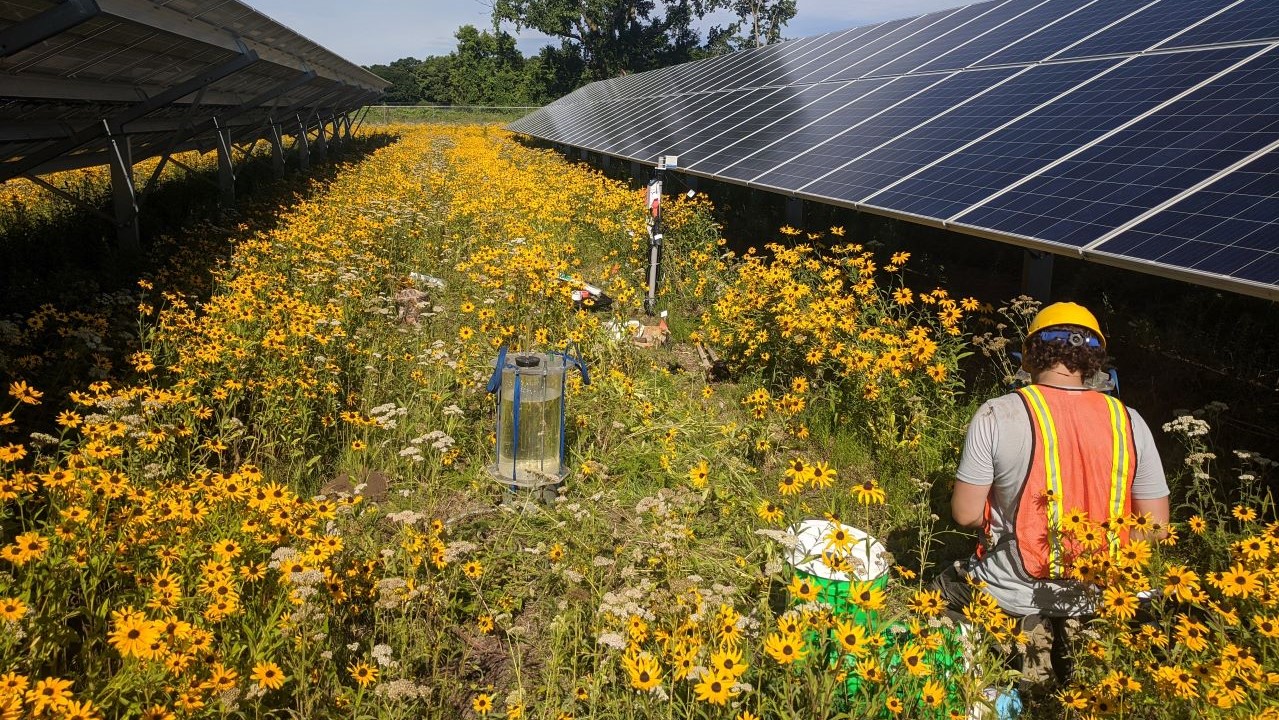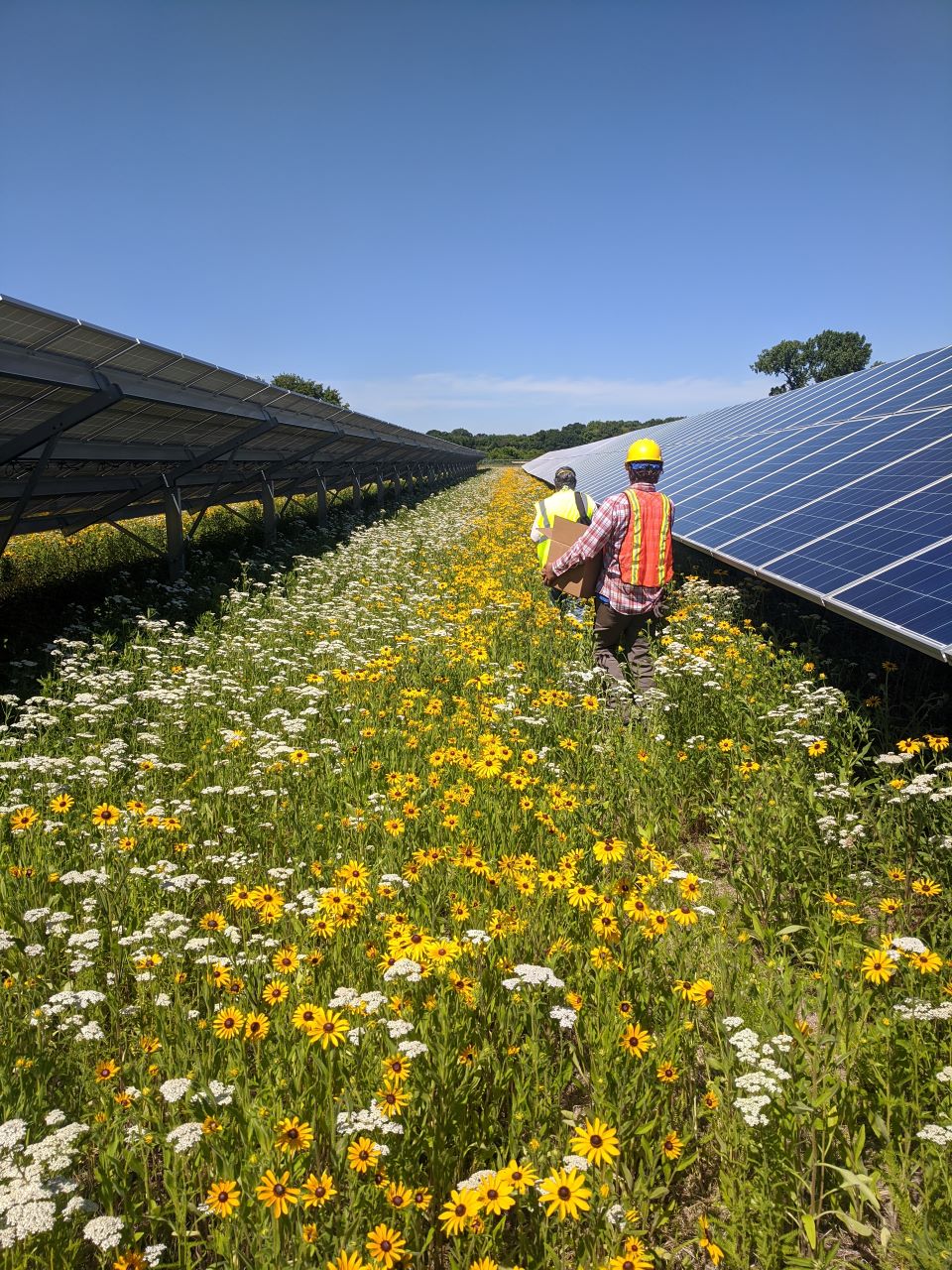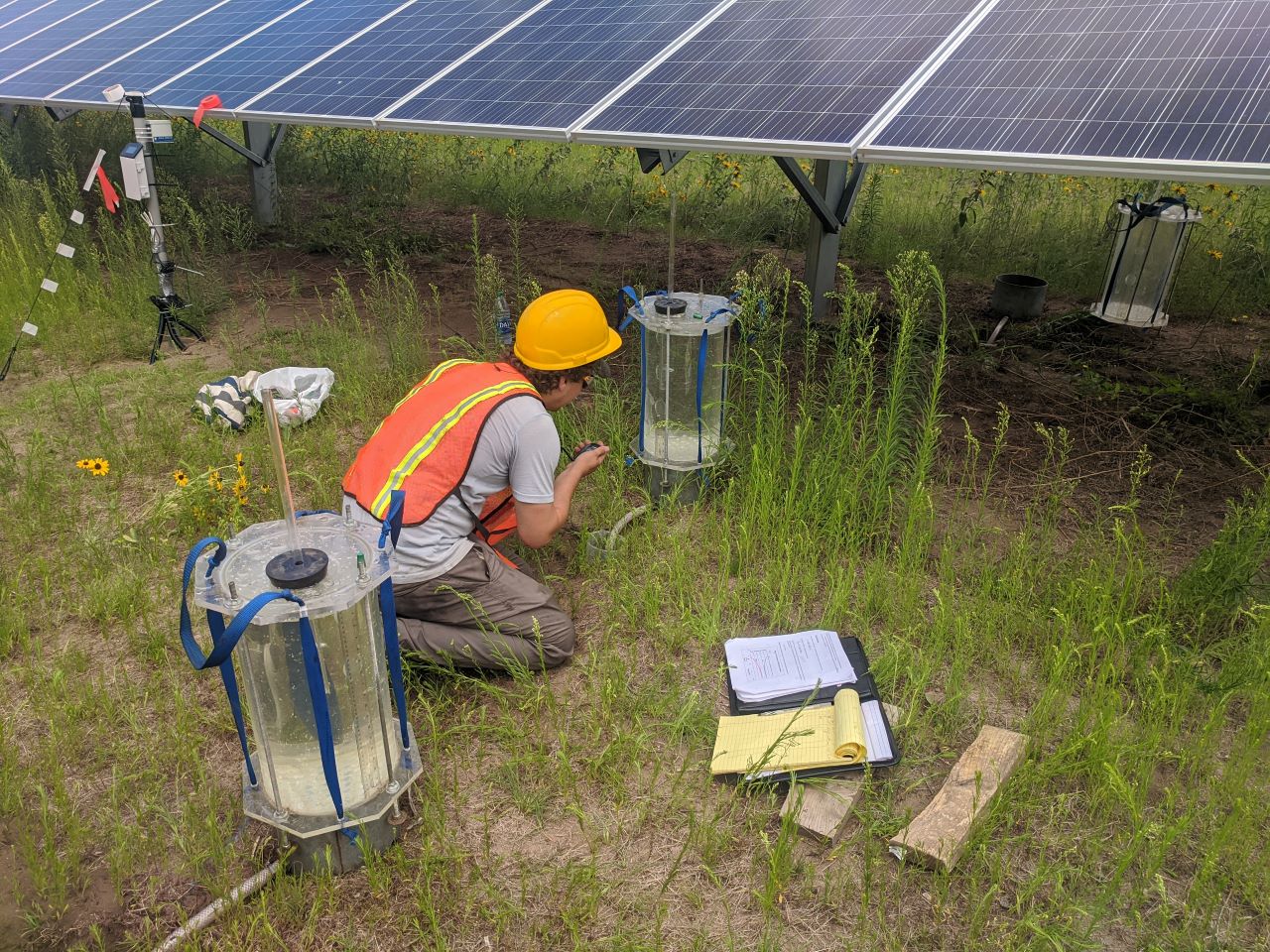

Developer: Engie Distributed Solar for Connexus Energy
Location: Ramsey, Minnesota (Anoka County)
Size: 3.4 MW solar, 6 MW storage
Soil type: Sandy
Annual precipitation: 37 inches
Ground cover: Pollinator-friendly mix scoring “Exemplary” on Minnesota’s pollinator-friendly solar scorecard
Funded by the U.S. Department of Energy’s (DOE) Solar Energy Technology office, the Photovoltaic Stormwater Management Research and Testing (PV-SMaRT) project from DOE’s National Renewable Energy Laboratory, Great Plains Institute, Fresh Energy, and the University of Minnesota is using five existing ground-mounted photovoltaic (PV) solar sites across the United States to study stormwater infiltration and runoff at solar farms. Together, the five sites represent a range of elevations, slopes, soil types, and geographical locations that will help solar developers and owners, utility companies, communities, and clean energy and climate advocates better understand how best to support solar projects and the host communities in which they are built, in particular lowering the costs of clean energy development while ensuring protection of the host community’s surface and ground waters.
Site background
Located in Ramsey, Minnesota, 30 miles northwest of the Minneapolis-St. Paul metro area, Connexus Energy’s Ramsey Renewable Station project is one of the PV-SMaRT project sites. Developed on 18 acres of county-owned land near the Mississippi River, the solar project is flanked by an RV service center to its east, a highway to the north, and a specialty vegetable farm that grows pumpkins and peppers on the project’s west and south sides. And, thanks to the team at Bare Honey, a Minnesota-based honey producer, the site hosts beehives too. The 3.4 megawatts of solar panels face south, in a two-in-portrait configuration on a fixed-mount racking system. Throughout the array, the panels are 24-36″ above the ground at the lowest edge.

But community-integrated solar farms like the Ramsey site aren’t foreign to Minnesota: This installation is one of several hundred distribution-grid-scale solar arrays across the state. Most community solar projects in Minnesota are a result of the state’s community solar garden program, which is the largest of its kind in the nation. The Connexus site is similar to municipal and co-operative shared solar installations elsewhere in the state.
Still, the Ramsey site is special: The site not only has sandy soil but was seeded with a pollinator-friendly vegetation mix. The pollinator-friendly aspect was in fact the lynch pin in garnering community support. Pollinator experts and ecologists testified this wouldn’t be just any solar development—it would be pollinator-friendly, giving work opportunities to local seeders and apiarists as well as providing ecological benefits to nearby crops and the surrounding watershed. And thanks to the soil-vegetation combo, when it rains—or even pours—the excess water simply soaks into the ground, which has significant meaning for researchers, solar developers, utilities, and clean energy advocates alike.
Research process and stormwater findings
When engineers and researchers sit down to plan out or conduct analyses on clean energy developments like solar farms, they often utilize something called a design storm to test how well the site will hold up against an extreme weather event like a flood. A design storm is essentially a test flood event of a certain magnitude—the higher the magnitude, the more intense the test storm for modelling and analysis purposes. These tests help researchers and engineers monitor rainfall and soil moisture as well as determine how fast excess water soaks into the ground during extreme storms.
When the PV-SMaRT research team began developing models for Connexus’s Ramsey site, they discovered that, against three design storms—a two-year frequency storm, 10-year frequency storm, and 100-year frequency storm, the most intense of the three—all stormwater was channeled into the soil by the deep-rooted vegetation. Using both an InVEST modeling framework and a 2D Hydrus water model, University of Minnesota (UMN) researchers involved in the PV-SMaRT project, including Aaron Hanson and Jake Galzki, led by UMN professor Dr. David Mulla, have been able to keep tabs on the site, monitoring data and moisture probes, and comparing numbers from the site to those of other PV-SMaRT locations.

In fact, the team found that, if they wanted to observe a runoff response, they had to actually reverse engineer the site to provoke one. For example, if the team conducted a model of the site in which vegetation suffered due to heavily compacted soil, then they could observe a runoff response. But, in virtually every other scenario, the combination of the diverse, deep-rooted pollinator-friendly vegetation and sandy soil ensures that all excess water soaks directly into the ground. In Dr. Mulla’s eyes, that made the Connexus Energy Ramsey site a prototype for the rest of the PV-SMaRT project. “When we saw just how well this site stood up against the 100-year design storm, we knew it should become a sort of prototype and be incorporated into the national PV-SMaRT study and our recommended best practices for stormwater management at solar sites,” he says.
Project and site benefits
Brian Ross, vice president at GPI, puts it this way: “This site is important because it is the bookend—it is a site that requires only ground cover green infrastructure in almost any circumstances. Comparing this site to our other project sites is incredibly useful. The characteristics at play at Connexus Energy’s Ramsey solar site point toward the potential capacity of a solar farm to mitigate not only the site, but also contributing to broader watershed management.” Brian adds, “As a result of this study, stormwater permitting at sites such as this can be predictable and transparent to both the city or county and the developer, reducing soft costs for solar developers while ensuring good water quality outcomes for regulators and habitat co-benefits for local communities.”
Rob Davis, communications lead for Connexus Energy, says, “Noting overwhelming positive community response, Connexus requires pollinator-friendly ground cover for all our solar sites, and it was especially important for this project due to the location near the Mississippi River and a specialty crop grower. The site’s soil and ground cover combine to easily handle heavy rainfall events.” Rob notes that when the project was built, it did not have the advantage of accurate hydrological models for the PV solar project, which resulted in a requirement for grading that included carving a two-foot bump diagonally through the project. “Insights from the PV-SMaRT study will help guide policy such that grading—which both unnecessarily disturbs the soil and creates an uneven surface for vehicles managing the site—can be avoided. High-performance vegetation, with less grading and fewer stormwater containment basins, is a much better use of limited dollars.”
Stakeholder feedback
Data and observations from the Connexus Ramsey site now serve as a benchmark as the PV-SMaRT research team continues to gather insight about each of the other four project sites across the country. Overall, these findings further validate the project’s recommended best practices. We can help lower the soft cost of clean energy development and of ongoing maintenance as well as protect the host community’s surface and ground waters, create needed habitat, sequester carbon in the soil, and help craft a truly sustainable clean energy future that will benefit everyone for generations to come.
Throughout 2022, experts and stakeholders will be reconvening in this process to continue to examine and provide feedback on this foundational research. Get the latest updates from Great Plains Institute, and stay tuned for more PV-SMaRT case studies from Fresh Energy and partners in the coming months!
